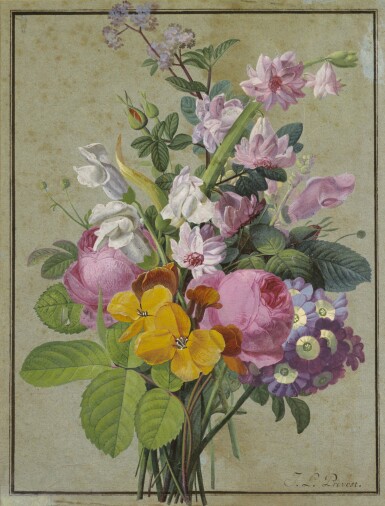
Property from Wildenstein & Co., New York
JEAN-LOUIS PRÉVOST, CALLED LE JEUNE | BOUQUET DE FLEURS
Lot Closed
June 25, 03:46 PM GMT
Estimate
10,000 - 15,000 USD
Lot Details
Description
Property from Wildenstein & Co., New York
JEAN-LOUIS PRÉVOST, CALLED LE JEUNE
Nointel (Picardie) circa 1760 - after 1810
BOUQUET DE FLEURS
Gouache on blue-gray paper, within two sets of brown ink framing lines;
signed in brown ink, lower right: J.L. Prevost.
sheet: 301 by 232 mm; 11⅞ by 9⅛ in
framed: 42 by 35 cm; 16½ by 14 in
Sale, Paris, Hôtel Drouot, Dessins anciens et tableaux anciens des XVIIe,
XVIIIe et XIXe siècles, 15 March 1989, lot 80
"Jean Louis Prévost was part of a large and highly skilled family of artists, however the standard of his work, both painted and drawn, was of such quality that he soon established himself, alongside Pierre Joseph Redouté, as the leading botanical artist of his generation in France. This delightful bouquet de fleurs, perfectly encapsulates all that is most desirable in his work, with the gouache medium maintaining all its original vibrancy of color and exquisite detail."
Alexander Faber
Jean Louis Prévost was the predominant member of a family of French painters who specialized in the depiction of flowers and fruit. He was born in the village of Nointel, near Beaumont-sur-Oise, and received his training in Paris, in the studio of Jean Jacques Bachelier. His exquisite paintings were highly sought after in the second half of the eighteenth century. Examples of his work were then to be found in the great collections of the day, including those of the Prince de Conti, the Marquis de Livois, the Marquise de Langeac, and the financiers Nicolas Beaujon, Augustin Blondel de Gagny and Alexis Janvier La Live de la Briche. The Cabinet des Estampes at the Bibliothèque Nationale in Paris preserves a set of
more than forty gouaches by Prévost le jeune depicting the various ornamental uses
of flowers. For a detailed discussion of the artist and his oeuvre, see Michel and
Fabrice Faré, La Vie silencieuse en France: la nature morte au XVIIIe siècle, Fribourg
and Paris, 1976, pp. 286-290.
